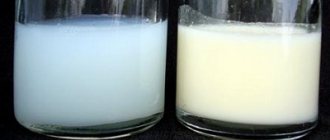Is it possible to drink whole, boiled, pasteurized food while breastfeeding?
The consumption of milk during lactation causes a lot of controversy and expert opinions are divided . Some talk about the benefits of the drink, since the calcium it contains is necessary for the formation of bones in a child. Others categorically prohibit drinking the product, claiming that it causes allergies, stool disorders, bloating and other health problems.
If before pregnancy the mother drank milk and does not want to give it up after giving birth, then she can safely include it in the menu, provided that the baby does not have a negative reaction to the new type of food.
IMPORTANT: the exception is premature babies, whose body only by the 9th month of life begins to produce a sufficient amount of the enzyme necessary to digest milk sugar, protein and other elements.
Not all types of milk are safe, and to understand which one to choose, you need to consider the following:
- Whole milk (not processed, fat content is not regulated, difficult to digest, may contain pathogenic microorganisms) - during lactation it is better to refrain from such a product.
- Boiled (useful substances are partially destroyed due to high temperature) - it is safe for mom to drink, because Boiling neutralizes pathogenic bacteria.
- Pasteurized (heated for a certain time to a temperature of 60-80 degrees, which allows you to preserve the beneficial composition and extend the shelf life of the product) - optimally suited for feeding a nursing mother.
Why can’t it be used during breastfeeding in the first month after birth?
Milk has a beneficial effect on the body of the mother and her baby, but it can lead to complications , so in the first month after giving birth, it is better for a woman to refrain from consuming this product or drink it with caution.
Until the child reaches 6 months of age, you can only drink boiled drink.
Pediatricians are of the opinion that mothers should not drink milk until the child’s digestive system is fully formed. Basically, this happens no earlier than 2 months after birth. She also needs to first introduce fermented milk products into her diet and only then try the nutritious drink.
Benefits for the mother
Cow's milk is a unique natural product that strengthens the body and has a beneficial effect on all its systems. It has a rich composition and contains the following beneficial substances:
- magnesium – takes part in metabolism;
- calcium and phosphorus – strengthen teeth, hair, nails, skeletal system, improve the functioning of the central nervous system;
- methionine – participates in the process of fat metabolism, prevents liver dystrophy;
- tryptophan is the basis for the production of nicotinic acid and serotonin, prevents the occurrence of tuberculosis, diabetes and cancer;
- lysine – prevents the appearance of anemia, muscle dystrophy, normalizes the functioning of the liver and lungs, and promotes the creation of new blood cells.
Milk contains vitamins D, A, E, K, 20 types of fatty acids, proteins and milk sugar, which women need to replace after childbirth.
Regular consumption of the product helps reduce stomach acidity, normalize blood pressure and remove toxins from the body. Milk is an excellent remedy for insomnia, as it has a gentle effect on the nervous system and soothes the body.
We also recommend watching a video about whether a nursing mother can drink cow’s milk:
Is it possible to dilute breast milk with water for a baby?
The most reliable and beneficial thing for a newborn is breastfeeding. There are women who want to put their baby to the breast, but due to certain circumstances they are forced to feed with expressed milk. In this case, you need to know how to properly collect and store this valuable product.
If there is a shortage of milk, experts recommend expressing the remaining milk from the breast after each feeding so that more comes in. It is worth doing this procedure only until it becomes enough. Also, if the mother of the baby needs to go somewhere, it will be safer to leave a portion of expressed milk.
If you are rarely separated from your baby, you can express yourself manually, but if the mother has to go to work early or the baby was born weak, premature and does not latch on to the breast, then it is better to purchase a breast pump. If you have to feed only expressed milk, it makes sense to fight for every drop of it, because the benefits of mother's milk cannot be compared with anything else. Try to express at least once every 2-3 hours to maintain lactation for as long as possible. Now let's talk about everything in order.
For faster pumping, you can use a breast pump. They are manual and electric. With a manual breast pump, expression occurs by regularly pressing a certain mechanism. The electric one does all the work itself and is considered the fastest. When using a breast pump, read the instructions and manufacturer's recommendations, make sure that the nipple is located in the center of the funnel and the fit is tight. Keep the device clean.
There are several ways to store breast milk. It all depends on what savings period you expect. Some mothers doubt the question: can breast milk be stored in the refrigerator? You can store milk at temperatures from 0 to + 4 degrees for 7 days, but do not leave it in the refrigerator door.
If a mother is forced to feed her baby only expressed milk, then, of course, it makes sense to stock up on it for future use by freezing it. This milk can be stored for 2 weeks to 3 months. It all depends on which freezer it is stored in. If in a separate box or compartment with a door that you do not use for other purposes, this increases the shelf life to three months. Label the milk container with the date when you freeze it. It is not recommended to re-freeze milk (i.e. defrost and freeze again), or to add large portions of fresh milk to already frozen milk.
Heat frozen milk in warm water by lowering the milk container into it. In order for cold areas to thaw more actively, the vessel with milk must be shaken periodically. There are special devices for heating milk. If you are forced to leave your baby with relatives, then this option will be the safest because... The heater maintains the optimal temperature. After all, mother's milk cannot be overheated or boiled, otherwise it loses its beneficial properties. It is also prohibited to heat it in the microwave due to the likelihood of uneven heating. Thawed milk should not be stored for more than two days.
Many mothers will be surprised, but breast milk does not spoil at room temperature (25 C) and is stored for 4-6 hours. Substances contained in breast milk, even at this temperature, counteract harmful bacteria. This fact is confirmed by real research. That is, if a mother needs to express milk at work, then there is every chance of storing it without refrigeration and bringing it home. If in hot weather there is a need to move somewhere, then you will need a cooler bag. Or some mothers get out of the situation with the help of a thermos, which is pre-cooled with ice cubes.
Below are general guidelines for storing breast milk in different temperature conditions. Source: La Leche League International
Colostrum (expressed within 6 days after birth):
- 12 hours at room temperature 27-32 C (80.6-89.6 F)
Mature milk:
- at 15 C (59-60F) - 24 hours
- at 19-22 C (66-72 F) - 10 hours
- at 25 C (79 F) - 4-6 hours
- in the refrigerator at 0-4 C (32-39 F) - 8 days
Frozen milk:
- Freezer shelf inside the refrigerator, without a separate door - 2 weeks
- Freezer compartment with separate door - 3-4 months (temperature varies due to frequent door opening)
- Stationary (separate) deep freezer with constant temperature -19 C (0 F) - 6 months or longer.
Currently, there is a wide choice of containers for storing milk. You can use both glass and plastic containers - this issue is not at all important, the main thing is that the container must be of high quality, sterile, close tightly and be convenient for you. These can be bottles, special plastic boxes, and even bags designed to store breast milk. Plastic bags are convenient because they are attached to breast pumps, and some are even included in the kit. They are convenient to use and do not take up much space when stored. You should not store milk in ordinary plastic bags; this material is not intended for such purposes and they may tear when heated.
Feed your baby breast milk, even if you can’t put him to your breast or be close to him all the time. In the modern world, the process of collecting and storing breast milk can be greatly simplified thanks to numerous devices.
Healthy newborns enter the world well hydrated and maintain this supply if they are exclusively breastfed - day and night - even in the hottest and driest climates. However, the practice of giving water to infants under 6 months of age (the recommended period for exclusive breastfeeding) persists in many countries and entails the most serious problems for their health and nutrition. This collection of frequently asked questions addresses these issues and the role of breastfeeding in meeting your baby's water needs.
How can infants get enough water?
Depending on the temperature and humidity of the environment, as well as on the child’s weight and activity, the average daily fluid requirement of a healthy child varies from 80-100 ml/kg in the first week of life to 140-160 ml/kg in the period from 3 to 6 months . The baby can easily obtain these amounts from breast milk if breastfeeding is exclusive and unlimited for two reasons:
Breast milk is low in salts. One of the main functions of water is to flush out excess salts from the body through urine. Salts mean dissolved substances (such as sodium, potassium, chlorine, nitrogen ions). The kidneys, although immature until about 3 months of age, are able to concentrate excess salts in the urine to keep the body functioning. Because breast milk contains few salts, a baby does not need as much water to excrete them as an older child or adult.
Can feeding a baby under 6 months old with water be harmful?
Supplementing with water increases the risk of malnutrition. Replacing breast milk with liquids that have little or no nutritional value may adversely affect the baby's well-being, survival, growth and development. Even small amounts of water drunk fill the baby's stomach and reduce his appetite and desire to eat nutrient-rich breast milk. Research shows that supplementing with water before 6 months can reduce milk consumption by even 11%. Supplementation with glucose solution in the first week of life is associated with greater weight loss and a longer stay in the hospital. Supplementing with water increases the risk of disease. Water and what it comes from can carry pathogenic microorganisms. Infants are at greater risk of exposure to microorganisms that cause diarrhea, especially in areas with poor sanitation and hygiene. In less developed countries, two out of five people do not have access to safe drinking water. Breast milk provides the baby with sufficient, always-available clean water. Studies from the Philippines confirmed the protective effect of exclusive breastfeeding and the harm of early supplementation with non-nutritive liquids on the risk of diarrhea. Depending on age, the risk of diarrhea for an infant given water, teas and herbal infusions was 2-3 times higher than for an exclusively breastfed infant.
What is the water requirement of children over 6 months?
Recommendations for water consumption in the second 6 months of a child’s life are not as clear as for the first half of infancy. At six months, you should start giving complementary foods - food that is given to the baby in addition to breast milk to meet the baby's increased nutritional needs. Your baby's water needs will be influenced by the type of complementary foods he receives. For the most part, a baby's water needs between 6 and 11 months are met by breast milk. Additional water can be offered in the form of fruit or fruit juices, vegetables, or small amounts of boiled water can be offered after the baby has eaten complementary foods.
Care must be taken to ensure that water and other liquids do not replace breast milk in the baby’s diet. Water can replace or dilute the nutritional value of energy-dense complementary foods. Liquid cereals, soups, broths and other liquid meals given to a baby are usually much less energy dense than the recommended 0.6 kcal/g for complementary foods. If less water is added to these complementary foods, the nutritional status of children in this age group may be improved.
Is it possible or not to give it to a baby?
The mother's lack of breast milk or its absence makes parents think about supplementing their baby with cow's milk. However, 1 liter of such a product contains 30 g of protein, while mother’s milk contains only 9-10 g/l, which can significantly increase the load on the newborn’s kidneys.
It is precisely because of protein overload that experts do not recommend using cow's milk for feeding children in the first months of life . In addition, this product in the diet of children under 1 year of age can lead to iron deficiency in the body, cause minor hemorrhages on the mucous membrane and cause growth impairment.
When should you start feeding it to your baby?
Research by specialists has shown that breast milk is perfectly absorbed in the child’s body, and the unbalanced composition of the cow’s product is quite fatty and can provoke the appearance of various diseases, incl. and allergies.
For these reasons, pediatricians advise not to rush to introduce whole milk into the baby’s menu until the age of 3, until his body begins to absorb other foods without side effects.
In some cases, after consultation with a pediatrician, you can start getting acquainted with the drink at 9 months or a year, but only if you add it to cereals.
Benefits for the child
For children over 3 years of age, cow's milk may be beneficial for the following reasons:
- is a source of calcium, which is normally absorbed at this age and promotes bone formation;
- replaces other drinks that provide complete and varied nutrition;
- contains vitamins B, D, A, C, E and carbohydrates that supply the body with energy;
- strengthens the immune system.
A small amount of warm milk with honey (in the absence of contraindications) helps cure a cough.
Water in the diet of bottle-fed and mixed-fed children
Not all newborns and children under one year old are breastfed, despite its benefits. The reason for this may be:
- maternal infectious diseases;
- absence or shortage of milk in a woman;
- mother's refusal to breastfeed.
Introducing formula, even as a supplement to breast milk, will require more fluid to break it down. However, modern mixtures, when diluted with water according to the instructions, are easily absorbed even without it.
The reason for supplementing a bottle-fed or mixed-fed baby may be constipation, unreasonable anxiety, or signs of dehydration.
The amount of liquid is also determined individually; on average, the daily portion should be 100-200 ml during the day.
So that water does not replace the formula, but replenishes the lack of fluid, it should be given half an hour to an hour after feeding.
What is dangerous for mother and baby?
Despite the fact that milk contains elements important for human development and growth, doctors remind that the product is one of the most powerful allergens. This is due to the fact that the protein entering the body is recognized by the immune system as foreign and is rejected. Mother and baby may experience negative reactions:
- peeling of the skin, rash, redness;
- indigestion (regurgitation, vomiting, loose stools or constipation, colic, bloating);
- breathing problems (cough, rhinitis, asthma).
You should also exclude the product from the diet if the baby is not gaining weight well, is restless, sleeps soundly and for a long time, or if one of the family members has a tendency to allergies.
IMPORTANT: if the above symptoms are detected after breastfeeding, the mother should immediately eliminate cow's milk from her diet and not give it to the baby.
Is it possible to give dairy products to dogs?
In dairy products, the content of all useful substances is retained, but they do not act as aggressively on the gastrointestinal tract as whole milk. Therefore, to diversify your diet, it is better to choose products that contain processed lactose.
Can dogs have kefir?
The fermented milk product is easily absorbed and digested, the nutrients and beneficial substances from it are easily absorbed, without causing digestive problems. The product is offered to babies left without a mother, and can also be given as complementary food to a puppy aged one month or older. Suitable for adults. However, kefir has a sour taste and not all animals agree to drink it.
It is also worth considering the peculiarity of kefir. A fresh product has a mild laxative effect, and a three-day product will have a pronounced strengthening effect. For dogs prone to constipation, it is better not to pour it.
Can dogs have cottage cheese?
This is an irreplaceable source of easily digestible calcium, phosphorus, and B vitamins. This product is useful to give both to puppies for active growth and development, and to nursing dogs.
Cottage cheese can be given to dogs every other day, the dosage depends on the size and age. For an adult Labrador, a serving is 100-150 g, and for a baby Chihuahua, a single serving should not exceed 30-50 g.
For puppies, a raw chicken egg is added to the product for greater nutrition.
Is it possible to give a dog cheese?
This is a fairly fatty product, so it is most often chosen as a treat and reward during training. You shouldn’t overdo it; 20-70 grams per day is quite enough.
You should take low-fat cheese, without flavoring and aromatic additives, mold and dyes. But you can’t feed your dog cheese all the time. And in general, before consuming this delicacy, you should thoroughly study whether dogs can have cheese.
Can dogs eat yogurt?
This fermented milk product contains bifidobacteria and lactobacilli, which convert milk sugar into acid. Yogurt is mildly digestible and does not cause negative reactions from the gastrointestinal tract.
It is recommended to give yoghurt to pets with indigestion to restore intestinal microflora. To do this, you can offer your dog half a glass of natural yogurt without sugar or any other additives before each feeding.
Is it possible to give a dog baked milk?
It is produced by bringing to a boil and then heating for a long time. At the same time, most of the beneficial substances are preserved. Baked milk does not cause such a sharply negative reaction from the gastrointestinal tract as whole milk, therefore it can sometimes be offered to your pet as a treat and enrichment of the diet.
Important: Any type of dairy product cannot replace water. There should always be clean drinking water in the bowl, especially with dry food.
Recommendations
If a mother shares the opinion of doctors and is ready to introduce cow’s milk into her diet, she should follow some tips so as not to harm herself and the health of the newborn:
- Fresh milk must be boiled and diluted with water in a ratio of 1:3.
- Choose your product carefully, buying it from trusted sellers and manufacturers.
- Study the composition indicated on the label (it should not contain artificial additives or preservatives).
- Pay attention to the expiration date and storage conditions.
- Introduce it to the menu only after the baby has successfully become acquainted with fermented milk products.
In the future, a nursing mother can consume no more than 100 ml of the product per day in several doses. However, you should not combine it with fresh fruit to avoid fermentation.
How to properly diversify your diet?
When deciding to diversify your diet with a natural product, you need to remember simple rules:
- start with a minimum amount (2 tbsp);
- drink in the morning and carefully monitor the child’s reaction;
- do not introduce new types of food on the same day;
- consume in portions (in dishes with a small amount of milk - porridge, omelettes or tea);
- consume heated milk, otherwise it will stick to the walls of the esophagus in the form of a sticky substance.
Porridge for babies with milk
The extreme usefulness of porridges has been known since ancient times. In addition to the fact that they contain many elements necessary for a little person, they also contribute to the development of the infant’s digestive system, stimulating intestinal function.
To properly cook any porridge, be it buckwheat, rice or wheat, you need to know the basic recipe for making milk porridge for infants. And, as you understand, there are a great many variations on this theme.
To begin with, sorted and washed cereals are boiled in water until tender. Then it is ground through a sieve. And only after that boiled milk is added to it. Moreover, the milk is pre-diluted, as indicated above. The porridge should be made with a consistency similar to sour cream.
After you have mixed everything thoroughly, the resulting mixture should be brought to a boil again, this time with milk. That's the whole secret of cooking.
We suggest you read: Basophils are elevated in a child - what are the reasons for the deviation from the norm?









